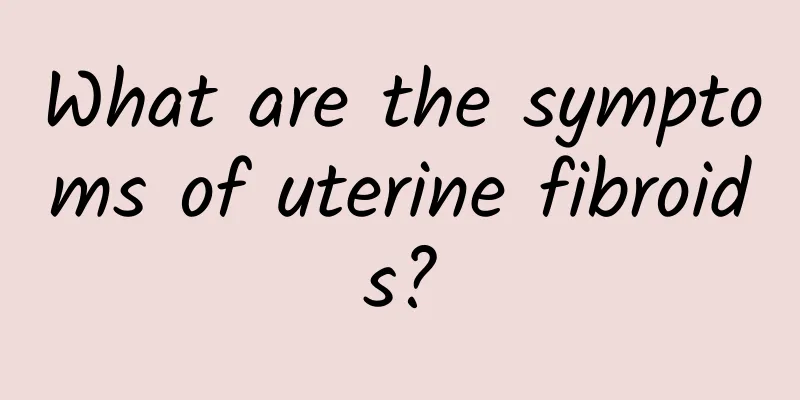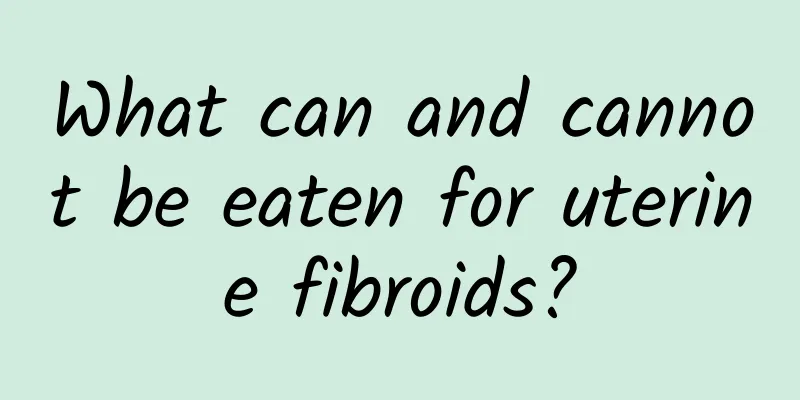What are the symptoms of uterine fibroids?

|
Speaking of uterine fibroids, I believe this is not unfamiliar to women. Uterine fibroids can be said to be an important reason that seriously threatens women's health in today's society. In the early stages of uterine fibroids, there are often no obvious symptoms, which makes it difficult for people to detect, which makes many women unable to prevent it. So what are the symptoms of uterine fibroids? Let me introduce you to this aspect: Symptom 1: Backache and abdominal pain: Common symptoms include lower abdominal distension, backache, etc. Acute pain may occur in some special cases, such as torsion of pedunculated fibroids, or red degeneration of fibroids during pregnancy, which may be accompanied by fever. Symptom 2: Abdominal mass: When the mass is large or grows too fast, you can often feel a mass in the middle of the lower abdomen. It is hard in texture and is easier to feel in the early morning when the bladder is full. Symptom three: increased leucorrhea: Intramural fibroids increase the area of the uterine cavity, increase the secretion of endometrial glands, and are accompanied by pelvic congestion, resulting in increased leucorrhea. If it is a submucosal fibroid, its surface is prone to infection and necrosis, producing a large amount of purulent and bloody secretions accompanied by a foul odor. Symptom 4: Abnormal urination and defecation: If the fibroids are large or grow in the cervix, broad ligament, etc., clinical symptoms of squeezing the adjacent pelvic organs may occur, such as constipation, frequent urination, increased residual urine, ureteral displacement, hydronephrosis, etc. Symptom 5. Menstrual changes: When fibroids enlarge the uterine cavity, increase the area of the endometrium, poor uterine contraction or excessive endometrial hyperplasia, or submucosal fibroids, they can all manifest as prolonged menstruation and menorrhagia. If not treated in time, it can lead to anemia. Symptom 6: Infertility: According to literature reports, many women suffer from infertility due to fibroids compressing or twisting the fallopian tubes, affecting the normal function of the fallopian tubes, or fibroids causing deformation of the uterine cavity, hindering the implantation of the fertilized egg. Symptom 7: Uterine bleeding: This is the most common symptom of uterine fibroids, occurring in more than half of the patients. Cyclic bleeding is the most common, which can manifest as increased menstrual volume, prolonged menstrual period, or shortened menstrual period. It can also manifest as irregular vaginal bleeding without menstrual period. Uterine bleeding is more common in submucosal fibroids and intramural fibroids, while subserosal fibroids rarely cause uterine bleeding. The above article is what I introduced to you today about the symptoms of uterine fibroids. Female friends must seek timely and active treatment after suffering from uterine fibroids to avoid making the condition worse. I hope my reply can be of some help to you. |
<<: The relationship between sexual intercourse and menstrual irregularities
>>: How to prevent menstrual irregularities caused by excessive hormones
Recommend
This is a great idea! Eat with your left hand to control your food intake and lose weight successfully
Who doesn’t know that losing weight means eating ...
Pay attention to postmenopausal uterine bleeding
In the outpatient clinic, we often encounter some...
Will lack of sexual life lead to cervicitis? What are the types of cervicitis?
Cervicitis is more harmful, and the more common e...
What are the common symptoms of adnexitis in women?
I believe that many women are aware of the high i...
What are the advantages of ovarian cyst surgery?
Among many gynecological diseases, ovarian cysts ...
It is very important to take good care of vulvar leukoplakia in life
In life, we all want to know how to care for vulv...
Irregular vaginal bleeding is one of the early symptoms of ectopic pregnancy
For pregnant women, ectopic pregnancy has a great...
What's wrong with my period being dark four times in two months?
What's wrong with my period being dark four t...
Is it really true that being a little bit fat is okay?
The weather has been cold these days, so people e...
What should women do with dysmenorrhea?
What should women do when they have dysmenorrhea?...
Obesity has 5 landmines! Avoid nuts after 7pm
"Strange! Why can't I lose weight?"...
Black fungus diet recipes to detoxify and get a good figure
To lose weight through diet, there are three most...
What are the preventive measures for chronic adnexitis?
With the progress of the times, people's livi...
Eliminate edema and help lose weight by doing lymphatic stretching exercises easily
The most annoying thing is that you cannot lose w...
Eight things to do to easily prevent pelvic inflammatory disease
How to effectively prevent pelvic inflammatory di...









